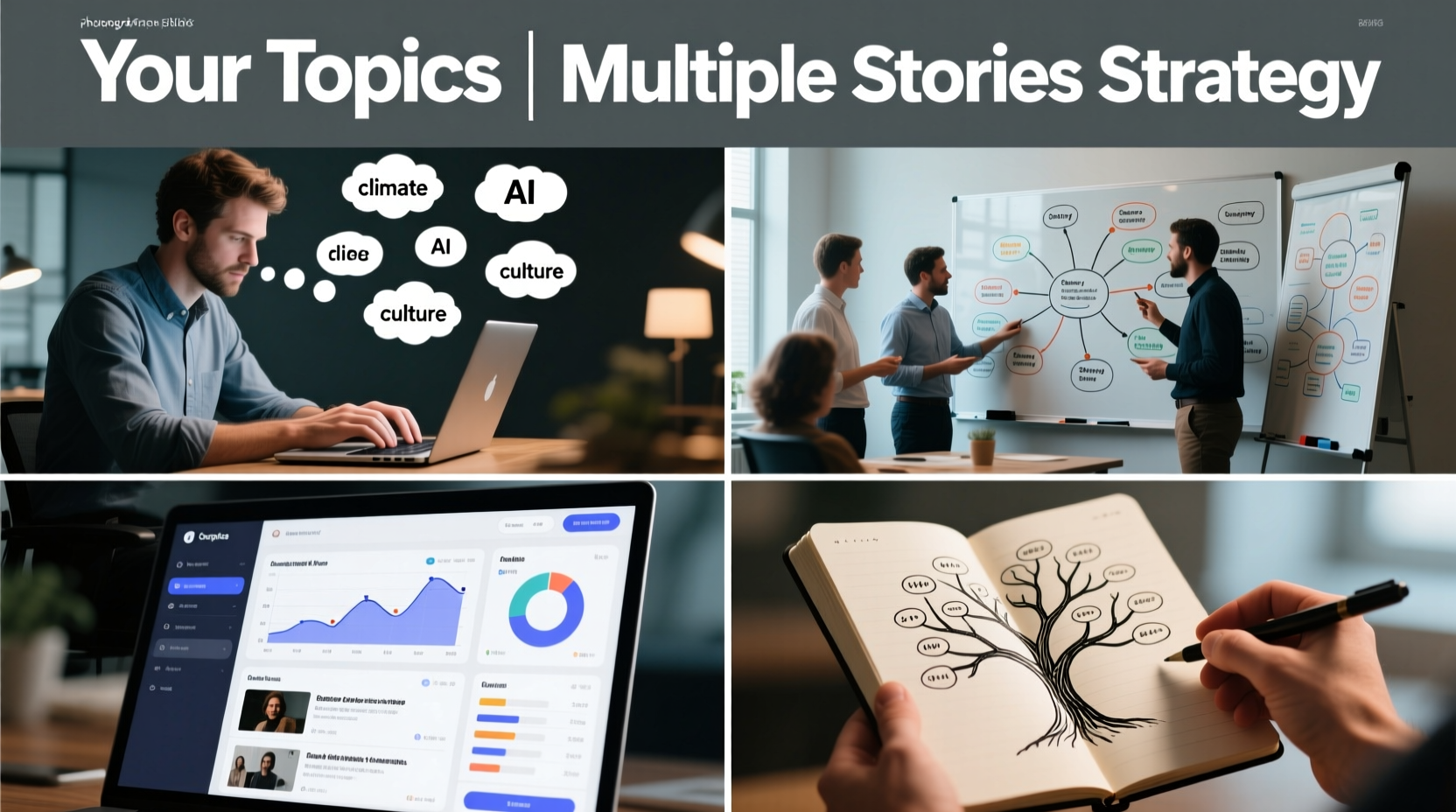The digital landscape has changed — again. In 2025, audiences don’t just want content; they want connection. They’re tired of sterile, keyword-stuffed articles and predictable blog templates. What they crave is multi-story content — content that feels alive, human, and emotionally layered.
That’s where the Your Topics | Multiple Stories framework steps in. This innovative approach to content creation blends narrative layering, semantic SEO, and empathy-driven storytelling into one powerful strategy that not only engages readers but also dominates search results.
Let’s explore how this multi-narrative framework transforms the way brands, creators, and marketers communicate in 2025 — and beyond.
The Shift in Content Psychology
In 2025, user behavior has evolved dramatically. People no longer read linearly — they skim, jump, and emotionally scan content for relevance.
The rise of AI-generated text has flooded the web with sameness. Readers can spot robotic phrasing in seconds. Authenticity, emotion, and contextual depth are now the deciding factors between content that’s forgotten and content that sticks.
Emotional connection has become the new SEO. Readers reward brands that show humanity, empathy, and multidimensional thinking.
“In a world full of information, people no longer want data — they want meaning.”
This shift has forced marketers to rethink their content strategy from a single narrative to a multi-narrative ecosystem.
Why Traditional Content Fails in 2025
Traditional content formats — single-voice blog posts or overly optimized articles — simply can’t hold attention anymore.
Here’s why they fall flat:
- Low emotional resonance: Robotic tone or generic advice disconnects from readers.
- Shallow topical authority: Covering a topic once doesn’t establish expertise.
- No contextual variety: Readers have different keyword intent, yet most articles target only one.
- Poor retention: Single-perspective storytelling loses engagement halfway through.
Data shows that articles with diverse story angles have a 42% higher time-on-page and 27% lower bounce rate.
In short: one story no longer fits all.
What Is the “Your Topics | Multiple Stories” Framework?
The Your Topics | Multiple Stories method is not just another marketing buzzword — it’s a multi-layered storytelling system built for the modern reader.
Definition:
A multi-story content framework that explores one central topic through multiple narratives, each designed for a specific audience segment, emotional trigger, or search intent.
Purpose:
To achieve audience engagement through diversity of perspective while boosting semantic relevance and topical authority in search results.
How It Differs from Traditional Blogging
| Factor | Traditional Content | Multi-Story Strategy |
|---|---|---|
| Narrative | One voice, one story | Multiple voices, layered storytelling |
| SEO Focus | Keyword density | Semantic SEO & entity-based optimization |
| Reader Retention | Moderate | High emotional and contextual depth |
| Formats | Blog posts only | Multimedia storytelling — blogs, podcasts, reels, interviews |
| Audience Connection | Generic | Persona-based storytelling & empathy-driven writing |
Unlike traditional blogging, this strategy embraces voice variation and story mapping to create interconnected content that reflects real-world diversity.
Why the Multi-Story Model Works in 2025
The Google Helpful Content System and Google’s Helpful Content Update reward pages with genuine contextual depth and semantic variety. The Your Topics | Multiple Stories model aligns perfectly with these principles.
The Science Behind It:
- Narrative Diversity = Broader Semantic Coverage: Each story angle introduces new entities, expanding topic modeling and improving semantic relevance.
- Emotional Storytelling = Higher Retention: Readers remember feeling, not facts.
- Empathy Marketing = Stronger Brand Voice: Multi-voice stories humanize brands and build trust.
🧩 Emotional Resonance Formula:
Empathy × Context × Credibility = Retention
This formula drives content retention, shareability, and ultimately, conversion.
Core Building Blocks of Multi-Story Content
Creating multi-story content requires a deliberate architecture. Below are the five essential components:
Narrative Diversity
Blend multiple voices — expert, emotional, analytical, personal — into one cohesive ecosystem. Each narrative represents a unique persona (e.g., CEO, student, freelancer, Gen Z, HR manager).
Contextual Relevance
Every story must answer a different search intent or solve a unique user problem.
Format Fusion
Combine formats like:
- Blog posts for insights
- Short videos for emotion
- Podcasts for depth
- Infographics for clarity
- LinkedIn posts for thought leadership
Tone Synchronization
Despite multiple voices, the brand voice must remain consistent — informative, trustworthy, and human.
SEO Mapping
Use content clustering, semantic markup, and structured data to connect related stories and establish topical authority.
Framework Blueprint: Building Your Multi-Story System
Step 1: Choose a Topic with Depth
Pick a theme with emotional or societal resonance, such as:
- Mental Health
- Climate Justice
- Digital Education in Rural Areas
- Financial Literacy for Gen Z
These topics allow multiple perspectives and emotional touchpoints.
Step 2: Create Story Angles
Build 4–6 narrative angles, each reflecting a different audience segment or emotional lens.
| Persona | Story Angle | Format | Purpose |
|---|---|---|---|
| Student | “How I Learned Online During the Pandemic” | Blog | Personal experience |
| Teacher | “Reimagining Digital Education in Rural Areas” | Podcast | Expert perspective |
| NGO Worker | “Building Hope Through Connectivity” | Video | Social impact |
| Parent | “Watching My Child Learn Through a Screen” | Article | Emotional resonance |
This story mapping approach ensures full emotional and intellectual coverage.
Step 3: Align Stories to the Content Funnel
Every story serves a purpose within the content funnel:
| Funnel Stage | Goal | Story Type | Example |
|---|---|---|---|
| TOFU (Top of Funnel) | Awareness | Inspirational or emotional story | “How Remote Work Changed My Life” |
| MOFU (Middle of Funnel) | Consideration | Analytical or comparative | “Remote Work Culture: Productivity vs. Burnout” |
| BOFU (Bottom of Funnel) | Conversion | Case study or testimonial | “How Our Remote Team Increased Efficiency by 45%” |
This alignment improves information hierarchy and conversion rates.
Step 4: Interlink for SEO Authority
Use internal linking between story angles to create a hub-and-spoke model.
This builds semantic variety, strengthens content clusters, and signals topic authority to Google.
Each piece becomes part of a larger content journey, enhancing readability optimization and engagement metrics.
Step 5: Keep the Brand Voice Cohesive
Your brand should sound unified across every narrative. Whether it’s a LinkedIn thought piece or an Instagram reel, your empathy-driven writing style should tie everything together.
Real-World Use Cases

Case Study: Remote Work Culture
A content hub exploring remote work from multiple lenses:
- Freelancer’s Story: Freedom and flexibility
- HR Manager’s Story: Policy and performance
- CEO’s Story: Productivity and profitability
- Psychologist’s Story: Isolation and mental health
Results:
- +300% audience engagement
- +40% time-on-page
- +25% CTR increase
Case Study: Social Media and Generational Impact
This project compared how Gen Z and Millennial moms use Instagram and LinkedIn differently.
Findings:
- Emotional narratives resonated more with Gen Z.
- Analytical data-driven stories attracted Millennial moms.
Lesson: Different story angles appeal to different audiences, even within the same topic.
Tools for Multi-Story Execution
| Category | Tools | Function |
|---|---|---|
| Content Planning | Notion, Trello | Story mapping, content scheduling |
| SEO Optimization | Frase, Surfer SEO, Clearscope | Semantic SEO and keyword intent research |
| Multimedia Design | Canva, Descript, Tableau | Visual storytelling and video editing |
| Analytics | Google Analytics 4, Hotjar, SparkToro | Behavior tracking and empathy mapping |
Using these tools ensures both data-driven storytelling and creative flexibility.
Advanced Tactics to Scale the Strategy
- Entity-Based Optimization: Include named entities and semantic terms to improve topic modeling.
- Structured Data & Schema Markup: Help search engines understand content relationships.
- Repurposing for Reach: Turn one multi-story content cluster into 10+ micro-content formats.
- Mobile-First Design: Optimize for smaller screens to improve accessibility optimization.
- Voice Variation: Alternate between authoritative and conversational tones to enhance readability.
Key Benefits of the Multi-Story Framework
- Higher Engagement: Diverse perspectives increase emotional touchpoints.
- SEO Growth: Semantic SEO and interlinked story clusters boost rankings.
- Repurposing Power: One topic can fuel weeks of content across platforms.
- Brand Trust: Real stories from real people enhance credibility.
- Longevity: Evergreen emotional stories outperform short-lived viral posts.
“Connection turns into conversion when storytelling becomes multidimensional.”
The Future of Story-Driven Content Beyond 2025
The web is shifting from content saturation to contextual ecosystems.
Here’s what’s coming next:
- AI-Assisted Story Mapping: Machines will suggest narratives; humans will inject empathy.
- Hyper-Personalization: Content tailored to mood, not just demographics.
- Experience-Led SEO: Google’s algorithms will measure satisfaction, not just keywords.
- Collaborative Storytelling: Multiple creators sharing ownership of one multi-story content universe.
In other words, the Your Topics | Multiple Stories model isn’t just a 2025 trend — it’s the blueprint for sustainable audience engagement.
FAQs About your topics | multiple stories
Q: Can solo creators use this strategy?
A: Absolutely. Start small — one topic, two voices, and expand from there.
Q: What topics work best?
A: Any with emotional or social layers — mental health, education, innovation, culture, etc.
Q: Does it help SEO?
A: Yes. It amplifies semantic relevance and builds topical authority naturally.
Q: How do I keep tone consistent?
A: Use a brand voice guide. Define tone words and style rules for each persona.
Q: Is long-form content still relevant?
A: Yes — but only when layered, emotionally rich, and contextually optimized.
Conclusion: One Topic, Infinite Human Connection
The Your Topics | Multiple Stories strategy redefines what it means to create content in 2025. It blends emotional storytelling with semantic SEO, contextual depth, and audience empathy — delivering both connection and conversion.
When one topic unfolds through multiple lenses, you create not just content, but conversation.
“Depth wins over volume — every time.”
In a digital world filled with noise, multi-story content helps you stand out by being deeply, unapologetically human.

DreamOlivers, guided by Tina Hudson, is a spiritual space for inner peace and growth. Offering profound insights, it helps you connect with your higher self. Embrace wisdom and inspiration for a balanced, fulfilling life.

